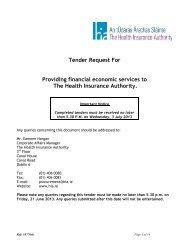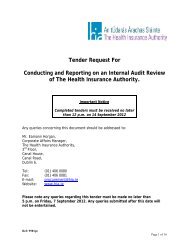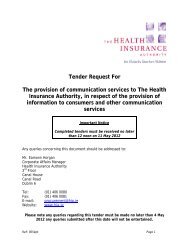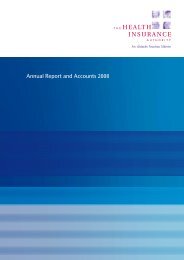Competition in the Irish Private Health Insurance Market
Competition in the Irish Private Health Insurance Market
Competition in the Irish Private Health Insurance Market
Create successful ePaper yourself
Turn your PDF publications into a flip-book with our unique Google optimized e-Paper software.
114. <strong>Private</strong> <strong>in</strong>surers have not implemented significant measures to enhance <strong>the</strong><br />
cost-effectiveness of care <strong>in</strong> a majority of OECD countries, ….<br />
116. Insurers face few <strong>in</strong>centives to manage care, especially for high-risk and<br />
high-cost cases, because <strong>the</strong>ir exposure to risk and cost is generally limited <strong>in</strong><br />
countries where PHI does not have a primary role, or where it has a m<strong>in</strong>or role <strong>in</strong><br />
f<strong>in</strong>anc<strong>in</strong>g more costly care. Management of care – and its cost-effectiveness – is<br />
not a priority for <strong>in</strong>surers <strong>in</strong> many OECD countries.<br />
117. Fur<strong>the</strong>rmore, <strong>in</strong>centives to manage care are challenged by some regulatory<br />
<strong>in</strong>struments. Mandatory or voluntary pool<strong>in</strong>g, or “risk-equalisation”<br />
arrangements, can help spread <strong>the</strong> cost of car<strong>in</strong>g for less healthy populations <strong>in</strong><br />
primary PHI markets (as <strong>in</strong> <strong>the</strong> Ne<strong>the</strong>rlands) as well as o<strong>the</strong>r markets (e.g.<br />
duplicate PHI <strong>in</strong> Australia76). They have been <strong>in</strong>troduced <strong>in</strong> order to counter any<br />
risk selection by <strong>in</strong>surers <strong>in</strong> <strong>the</strong>se markets. Yet <strong>the</strong>y carry trade-offs. While <strong>the</strong>y<br />
promote equitable risk pool<strong>in</strong>g across <strong>in</strong>surers, <strong>the</strong>y do not encourage <strong>in</strong>surers to<br />
manage care efficiently if <strong>the</strong>y compensate <strong>in</strong>efficient <strong>in</strong>surers for <strong>the</strong>ir higher<br />
costs. Some OECD countries are seek<strong>in</strong>g to ref<strong>in</strong>e <strong>the</strong>se arrangements as part of<br />
an ongo<strong>in</strong>g effort to strike an improved balance between <strong>the</strong>se two objectives.<br />
However, <strong>in</strong> addition to technical challenges, <strong>the</strong> development of such systems<br />
also entails policy choices about <strong>the</strong> priority to be given to <strong>the</strong> goals of promot<strong>in</strong>g<br />
efficient care management versus <strong>the</strong> need to compensate <strong>in</strong>surers for <strong>the</strong>ir<br />
different risk profiles.<br />
120. Better regulatory safeguards and improved <strong>in</strong>formation disclosure are also<br />
needed to enhance fair competition <strong>in</strong> a PHI market because of market<br />
imperfections such as <strong>in</strong>formation asymmetry and <strong>in</strong>surers’ <strong>in</strong>centives to select<br />
risks. Individuals need….<br />
“Regulation can promote access to PHI”<br />
123. OECD countries have utilised a range of regulatory tools to promote access<br />
to PHI coverage across population groups, particularly for those with higher<br />
anticipated health costs. PHI markets without such requirements or targeted<br />
<strong>in</strong>terventions often present access problems for high-risk <strong>in</strong>dividuals, as earlier<br />
experiences <strong>in</strong> <strong>the</strong> Ne<strong>the</strong>rlands and <strong>the</strong> United States have <strong>in</strong>dicated. Lack of<br />
access…<br />
124. Issuance requirements are one primary tool to improve access to PHI<br />
coverage. Several countries, <strong>in</strong>clud<strong>in</strong>g Germany, <strong>the</strong> Ne<strong>the</strong>rlands and some US<br />
states, have required <strong>in</strong>surers to issue at least one standard package to all<br />
applicants. One….<br />
126. First, <strong>the</strong>re are market-wide restrictions on <strong>in</strong>surers’ ability to consider<br />
health status when calculat<strong>in</strong>g premium rates. These can range from prohibitions<br />
on <strong>the</strong> consideration of risk factors, to restrictions on <strong>the</strong>ir use. These<br />
standards….<br />
127. Ireland and Australia, and many US states, <strong>in</strong> <strong>the</strong>ir small group markets,<br />
have accompanied <strong>the</strong>se rat<strong>in</strong>g reforms with risk-equalisation schemes which<br />
seek to compensate <strong>in</strong>surers cover<strong>in</strong>g a higher risk population. These schemes<br />
can also help promote fair competition among <strong>in</strong>surers. Phas<strong>in</strong>g <strong>in</strong> <strong>the</strong><br />
implementation of rat<strong>in</strong>g reforms over time, ra<strong>the</strong>r than implementation <strong>in</strong> a<br />
s<strong>in</strong>gle step, may also help avoid market <strong>in</strong>stability and dramatic shifts of covered<br />
<strong>in</strong>dividuals between <strong>in</strong>surers or <strong>in</strong> and out of <strong>in</strong>surance. New York and Vermont<br />
158







